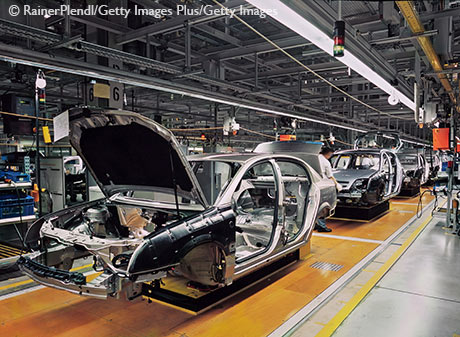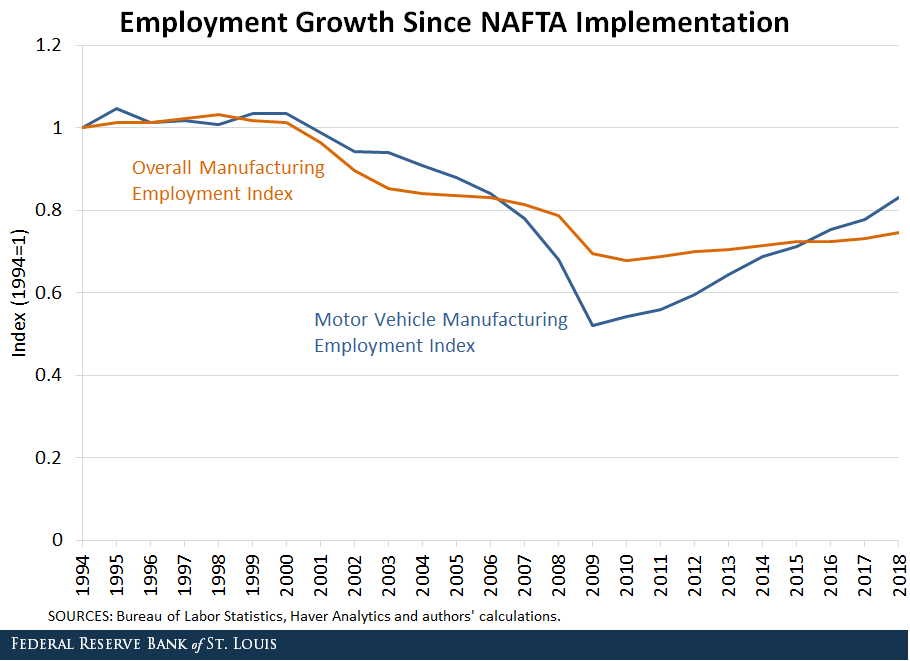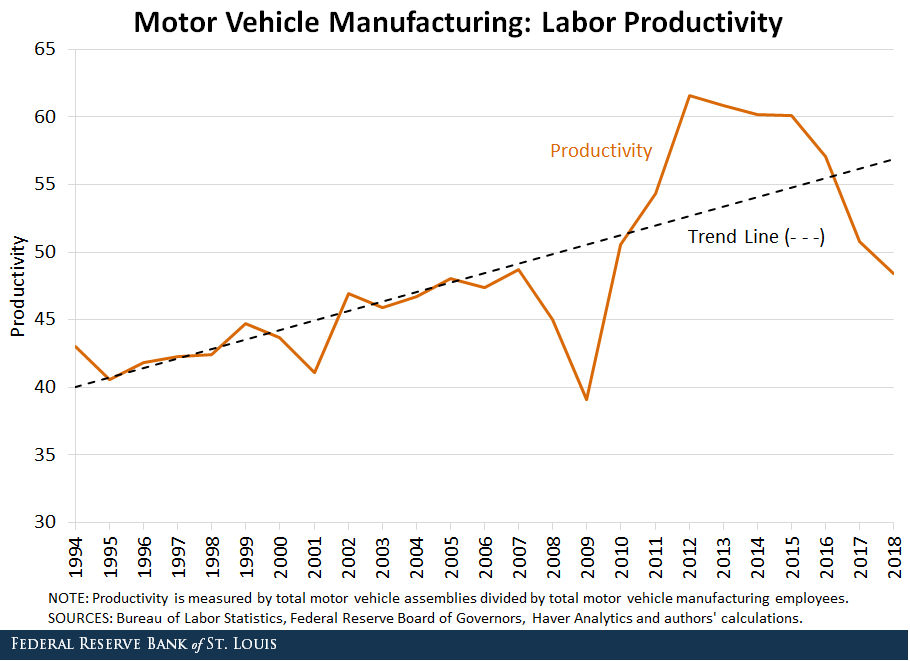The U.S. Auto Labor Market since NAFTA

Some are worried that free trade has disadvantaged the U.S.’s competitiveness in automotive production. The recent renegotiation of the North American Free Trade Agreement (NAFTA) exemplifies this concern, since trade rules for the auto sector received an overhaul. The hope is that these new rules will:
- Incentivize auto manufacturers to assemble more vehicles in the U.S.
- Boost employment
- Reduce the country’s trade deficit
In this post, we will look at how the auto labor market has evolved since the implementation of NAFTA and how feasible it would be to reduce U.S. imports of vehicles.
Auto Industry Employment
U.S. motor vehicle manufacturing employment in the U.S. totaled 281,600 workers in 1994 when NAFTA was implemented. Motor vehicle manufacturing consists of assembling complete vehicles (i.e., body and chassis or unibody) or manufacturing chassis only; this industry does not include parts manufacturing. We used North American Industry Classification System code 3361. This amount remained steady the rest of the decade but began to decline in the early 2000s. Employment contracted sharply during the Great Recession, and it reached a low in 2009, with employment at 50 percent of its 1994 level.
As of 2018, employment in this industry stood at 233,700 workers (similar to its 2006 level), a 17 percent decline since 1994. However, this decline is very much in line with what we see in overall manufacturing employment, as seen in the figure below.

Overall manufacturing employment and motor vehicle manufacturing employment have followed similar growth paths since 1994. Motor vehicle manufacturing employment growth declined at a slower rate, but it dropped precipitously during the Great Recession. It has since recovered and is performing better than overall manufacturing employment.
Why Manufacturing Employment Declined
Economic research concludes that increased productivity—for example, producing the same output with fewer workers—explains most of the decline in overall manufacturing employment.Kehoe, Timothy J.; Ruhl, Kim J.; and Steinberg, Joseph B. “Global Imbalances and Structural Change in the United States.” Journal of Political Economy, April 2018, Vol. 126, No. 2, pp. 761-96. Indeed, we find that labor productivity has increased in motor vehicle assembly production as well.
We calculated this industry’s labor productivity as total motor vehicles assembled divided by total motor vehicle employees, shown in the figure below.

Productivity steadily increased from 1994 to 2007 and then dipped during the financial crisis. It surged after the Great Recession but has dipped recently below trend.
We see that motor vehicle manufacturing employment declined 17 percent from 1994 to 2018, while motor vehicle productivity increased by about 13 percent over the same period. Productivity gains driven by technology (such as automation through robotics) can explain a large part of the decline in motor vehicle manufacturing employment because fewer workers are needed to assemble each vehicle.
Can the U.S. Reduce Imports of Vehicles?
Next, we will look at it how employment would have to adjust for the U.S. to eliminate its trade deficits in vehicles (that is, to become completely self-sufficient in supplying vehicles).
In 2018, U.S. vehicle sales were about 17.7 million, and the U.S. assembled about 11.3 million vehicles. If we assume that the U.S. becomes a closed economy in vehicle trade, it would have to produce an additional 6.4 million vehicles to satisfy demand.
Since in 2018 labor productivity was about 48 vehicles per worker, 6.4 million additional vehicles would imply about 131,000 new jobs in the auto sector. Such an increase would be an increase of more than 50 percent in motor vehicle manufacturing employment. However, completely eradicating the need for the U.S. to import vehicles is highly unlikely without drastic changes.
Issues with Becoming Self Sustaining in Vehicle Production
There are several issues involved. First, total unemployment in the U.S. is about 6.2 million. As of March 2019. About 2.1 percent of the currently unemployed would be required to satisfy this labor demand. Although 2.1 percent seems small, increasing employment in the auto sector would still be challenging given the tight U.S. labor market.
Furthermore, decreasing unemployment puts upward pressure on inflation, according to the Phillips curve. We estimate that if 131,000 workers were added to the motor vehicle manufacturing industry, it would decrease the current unemployment rate by 0.08 percentage points. In turn, this would add 0.05 percentage points to the inflation rate. Kumar, Anil; and Orrenius, Pia M. “A closer look at the Phillips curve using state-level data.” Journal of Macroeconomics, March 2016, Vol. 47, pp. 84-102.
One caveat to our analysis is that we only focused on auto workers directly involved in assembling vehicles, since it is directly comparable to vehicle assemblies. However, the manufacturing of vehicle parts and bodies is over 2.5 times the size of motor vehicle manufacturing in terms of employment. Either this industry would need to grow to supply more parts for the additional vehicles assembled in the U.S., or the U.S. would have to import more auto parts, which would further exacerbate the U.S’s trade deficit. The U.S. imported about $147 billion of auto parts in 2018. In 2012 dollars.
Conclusion
Although motor vehicle manufacturing employment has declined since NAFTA was implemented in 1994, this decline is similar to what we see in overall manufacturing employment. Also, much of this decline is driven by technology that increases productivity, meaning not as many workers are required to produce each vehicle.
Finally, completely eliminating the U.S.’s need to import vehicles would require over a 50 percent increase in motor vehicle manufacturing employment, an unlikely outcome without drastic changes.
Notes and References
1 Motor vehicle manufacturing consists of assembling complete vehicles (i.e., body and chassis or unibody) or manufacturing chassis only; this industry does not include parts manufacturing. We used North American Industry Classification System code 3361.
2 Kehoe, Timothy J.; Ruhl, Kim J.; and Steinberg, Joseph B. “Global Imbalances and Structural Change in the United States.” Journal of Political Economy, April 2018, Vol. 126, No. 2, pp. 761-96.
3 As of March 2019.
4 Kumar, Anil; and Orrenius, Pia M. “A closer look at the Phillips curve using state-level data.” Journal of Macroeconomics, March 2016, Vol. 47, pp. 84-102.
5 In 2012 dollars.
Additional Resources
- On the Economy: How Do Americans Feel about NAFTA?
- On the Economy: Did NAFTA Shift Car Making to Other Countries?
- On the Economy: How Many Workers Make Goods That Are Sold Overseas?
Citation
Yi Wen and Brian Reinbold, ldquoThe U.S. Auto Labor Market since NAFTA,rdquo St. Louis Fed On the Economy, April 15, 2019.
This blog offers commentary, analysis and data from our economists and experts. Views expressed are not necessarily those of the St. Louis Fed or Federal Reserve System.
Email Us
All other blog-related questions

